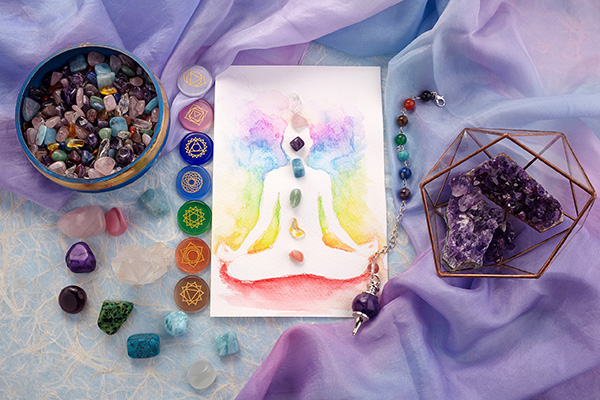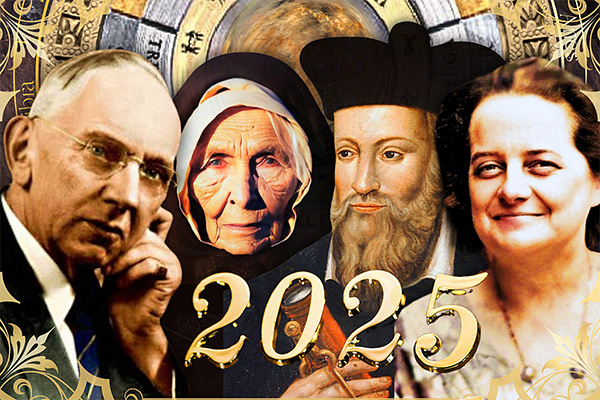 Lithotherapy, commonly referred to as crystal healing, represents a widely embraced alternative healing practice aimed at enhancing physical, emotional, mental, and spiritual wellness.
Lithotherapy, commonly referred to as crystal healing, represents a widely embraced alternative healing practice aimed at enhancing physical, emotional, mental, and spiritual wellness.
Nonetheless, lithotherapy is not a recent development. The roots of this healing practice can be traced back to ancient civilizations, with numerous indigenous cultures worldwide historically incorporating stones and other eco-friendly elements into their healing rituals and ceremonies.
Drawing from the Greek terms lithos (stone) and therapeia (healing), this timeless practice taps into the energies of crystals, stones, and minerals that engage with the human energy field to foster energy flow, alignment, and balance.
Lithotherapy leverages the natural energies present in the earth for a comprehensive healing strategy without relying on synthetic substances or artificial materials.
In modern times, lithotherapy has become a fundamental component of alternative medicine and energy healing, experiencing a surge in popularity as people increasingly integrate crystals and stones into their lifestyles and spiritual routines.
Every crystal possesses distinct metaphysical qualities, allowing practitioners to select stones that resonate with their unique needs and intentions. A prevalent application involves chakra energy work to cleanse, balance, and align the body’s energy centers, which are referred to as chakras.
Each chakra is linked to specific physical, mental, emotional, or spiritual dimensions of our existence, with particular crystals, stones, and minerals resonating with these energy centers to aid in restoring energy flow, function, balance, and wellness.
The chakras serve as specialized energy centers connecting us to the multidimensional universe. They function as dimensional gateways within our subtle bodies, absorbing and processing high-vibration energy to be assimilated effectively for the transformation of the physical body ~ Richard Gerber
Comprehending The Chakras
The chakra concept originates from ancient Indian spiritual traditions, particularly within Hinduism and Buddhism. It is especially highlighted in Tantra, Yoga, and Ayurveda, where early Vedic texts describe chakras as essential energy points that impact both physical health and spiritual wellness. Subsequent tantric and yogic philosophies have delved into energetic structures beyond these fundamental points, leading to a more comprehensive understanding of secondary chakras over time.
Gaining insight into all chakras provides a broader perspective on the body’s energy systems to optimize results with lithotherapy applications. The most commonly referenced chakra system constitutes seven primary (major) chakras, alongside numerous secondary (minor) chakras.
The conventional chakra system comprises these seven primary chakras—from root to crown—overseeing the growth, upkeep, and flow of life force energy throughout the body and our earthly experiences. These seven major energy centers traverse the spine, from the base to the crown of the head. Each primary chakra is linked to specific functions related to physical, emotional, mental, or spiritual aspects.
Secondary chakras are smaller energy centers dispersed throughout the body that supplement the seven primary chakras. They operate on a more subtle or etheric level, governing the multidimensional facets of the self. These chakras perform specialized energy tasks related to higher consciousness, spiritual awakening, energy grounding, and regulating particular health elements of the body or soul. They enhance the primary chakras and assist in maintaining energy flow and vibrational health across the body, mind, and spirit.
The principal distinctions are outlined below:
Location: Primary chakras are situated along the central energy channel (spine), while secondary chakras are located throughout the body in various spots.
Size and function: Primary chakras are more substantial and have a significant influence on overall well-being and spirituality, whereas secondary chakras are smaller and have a supportive function.
Function: Each primary chakra governs crucial aspects of physical, emotional, mental, and spiritual health. Secondary chakras bolster these functionalities by facilitating energy flow to defined areas of the body.
Disease often stems from a buildup of obstructed energy. By comprehending how energy moves through the chakras, we can begin to permit it to flow freely through our bodies, resulting in greater health ~Caroline Shola Arewa
Here is a comprehensive guide to lithotherapy for each of the primary and secondary chakras:
The Primary Chakras
ROOT CHAKRA (MULADHARA)
Location: Base of the spine
Crystals: Red Jasper, Hematite, Black Tourmaline, Black Onyx, Bull’s Eye, Garnet, Obsidian, Smoky Quartz.
Function: Governs courage, strength, stability, grounding, and sense of security; linked with blood and circulation.
Lithotherapy: Position the crystal on the lower back or at the base of the spine during meditation to enhance grounding and stability sensations.
SACRAL CHAKRA (SVADHISTHANA)
Location: Lower abdomen, positioned between the navel and pelvis
Crystals: Carnelian, Orange Calcite, Tiger’s Eye, Amber, Imperial Topaz, Sunstone, Moonstone.
Function: Regulates creativity, sexuality, vitality, and emotional equilibrium; related to kidneys, bladder, and bowels.
Lithotherapy: Hold the crystal over the lower abdomen or immerse it in a bath to boost creativity and emotional stability.
SOLAR PLEXUS CHAKRA (MANIPURA)
Location: Upper Abdomen/Solar Plexus
Crystals: Citrine, Yellow Jasper, Pyrite, Sulfur, Yellow Jade, Golden Tiger’s Eye.
Function: Controls personal power, assurance, and self-esteem; associated with the pancreas, liver, spleen, and stomach.
Lithotherapy: Place the crystal on the upper abdomen or don it as jewelry to foster confidence and personal strength.
HEART CHAKRA (ANAHATA)
Location: Center of the chest
Crystals: Rose Quartz, Green Aventurine, Rhodonite, Emerald, Unakite, Green Tourmaline, Rhodochrosite, Morganite, Malachite.
Function: Influences love, compassion, empathy, and emotional well-being; connected to the heart and lungs.
Lithotherapy: Hold the crystal over the heart or place it on the chest to nurture love and emotional healing.
THROAT CHAKRA (VISHUDDHA)
Location: Throat
Crystals: Blue Lace Agate, Aquamarine, Lapis Lazuli, Celestine, Blue Calcite, Blue Topaz, Turquoise, Blue Chalcedony, Sodalite.
Function: Governs communication, self-expression, and truth; associated with the thyroid, throat, and ears.
Lithotherapy: Position the crystal on the throat or wear it as a pendant to bolster communication and self-expression.
THIRD EYE CHAKRA (AJNA)
Location: Forehead between the eyebrows
Crystals: Amethyst, Sodalite, Labradorite, Lapis Lazuli, Azurite, Blue Sapphire, Fluorite, Ametrine.
Function: Regulates intuition, clarity, insight, inner vision and psychic awareness; associated with the nervous system.
Lithotherapy: Position the crystal on the forehead or hold it during meditation to amplify intuition and spiritual consciousness.
CROWN CHAKRA (SAHASRARA)
Location: Top of the head
Crystals: Clear Quartz, Amethyst, Selenite, Rock Crystal, Milky Quartz, Lepidolite, Diamond.
Function: Governs spiritual connection, enlightenment and higher consciousness.
Lithotherapy: Place the crystal atop your head or hold it during meditation to promote spiritual connection and enlightenment.
The Secondary Chakras
EARTH STAR CHAKRA
Location: Approximately 6-12 inches below the feet.
Crystals: Black Obsidian, Smoky Quartz, Hematite, Petrified Wood, Black Kyanite, Red Jasper, Shungite.
Function: Links the light body to the earth’s energy grid, providing grounding, stability and the integration of spiritual energy into the physical form and material realm.
Lithotherapy: Position the crystal beneath your feet while seated or lying down to support grounding and a stronger connection to the earth’s energy.
FEET CHAKRAS
Location: Centers of the soles of the feet.
Crystals: Black Tourmaline, Hematite, Red Jasper, Smoky Quartz, Moss Agate, Shungite, Tourmalinated Quartz.
Function: Grounds energy, connects with the earth’s healing vibrations, and helps expel excess or stagnant energy.
Lithotherapy: Place crystals directly under the soles of your feet while sitting or lying down to root and balance your energy.
SACRAL-LUMBAR CHAKRA
Location: At the base of the spine, situated above the base chakra.
Crystals: Carnelian, Tiger’s Eye, Mahogany Obsidian, Fire Agate, Garnet, Sunstone.
Function: Aids sexual and creative energy, as well as stabilizing the lower back.
Lithotherapy: Rest the crystal on the lower back or sacral area to invigorate creativity and physical vitality.
NAVEL CHAKRA
Location: Around the navel, just beneath the solar plexus chakra.
Crystals: Carnelian, Golden Calcite, Amber, Sunstone, Citrine, Orange Aventurine, Yellow Calcite.
Function: Manages creative energy, emotional stability, and connection to life force energy.
Lithotherapy: Hold the crystal over the navel during meditation to stimulate creative energy and emotional equilibrium.
SHOULDER CHAKRAS
Location: On the shoulders.
Crystals: Aquamarine, Chrysocolla, Lepidolite, Blue Lace Agate, Angelite, Fluorite.
Function: Concerned with burdens, responsibilities, and balancing life’s energetic weight.
Lithotherapy: Place a crystal on each shoulder during meditation or resting periods to ease tension and promote emotional balance.
HIGH HEART CHAKRA (THYMUS CHAKRA)
Location: Between the heart and throat chakras.
Crystals: Pink Kunzite, Turquoise, Rose Quartz, Morganite, Amazonite, Rhodonite, Prehnite.
Function: Governs unconditional love, compassion, spiritual connection, and higher communication.
Lithotherapy: Set the crystal on the upper chest or thymus region during meditation or healing practices to enhance compassion, forgiveness, and divine love.
KARMIC HEART CHAKRA
Location: Between the heart chakra and the throat chakra.
Crystals: Pink Kunzite, Rose Quartz, Rhodochrosite, Morganite, Green Aventurine, Danburite, Green Calcite.
Function: Manages karmic patterns, forgiveness, healing of karmic trauma at the soul level, and the facilitation of unconditional love and spiritual ascension.
Lithotherapy: Place the crystal on the upper chest or between the heart and throat chakras during meditation or healing sessions to release karmic imprints, foster forgiveness, and nurture divine compassion.
PALM CHAKRAS
Location: Centers of the palms.
Crystals: Clear Quartz, Selenite, Green Aventurine, Citrine, Labradorite, Pyrite, Hematite.
Function: Regulates healing energy and the capacity to transmit or receive energy through the hands.
Lithotherapy: Hold the crystal in your palm during energy work, healing sessions, or Reiki to amplify the flow of healing energy.
THIRD EYE MINOR CHAKRAS
Location: Near the temples or surrounding the third eye chakra.
Crystals: Lapis Lazuli, Labradorite, Blue Kyanite, Fluorite, Indigo Sapphire, Azurite.
Function: Enhances psychic insights, intuition, and clarity of thought.
Lithotherapy: Position the crystals on either temple during meditation or divination to heighten intuitive perceptions.
SOUL STAR CHAKRA
Location: Approximately 6-12 inches above the head.
Crystals: Selenite, Amethyst, Angel Aura Quartz, Celestite, Clear Quartz, Danburite, Labradorite.
Function: Facilitates the connection to higher self, soul purpose, and Akashic Records; serves as a gateway to divine consciousness.
Lithotherapy: Hold the crystal or position it over your head during meditation to enhance spiritual clarity and access elevated dimensions.
STAR/STELLAR GATEWAY CHAKRA
Location: Above the soul star chakra, the farthest point in the etheric body.
Crystals: Moldavite, Herkimer Diamond, Clear Quartz, Golden Aura Quartz, Phenacite, Tektite, Azeztulite.
Function: Connects to universal consciousness and realms beyond the physical dimension.
Lithotherapy: Hold the crystal or place it in a meditation area to tap into universal wisdom and multidimensional energy.
Crystals developed inside rocks like mathematical flowers. They extended and expanded, adding plane to plane in a reverent and flawless adherence to an absolute geometry that even stones – perhaps only the stones – recognized ~ Annie Dillard
Crystal Maintenance Guidelines
In order to ensure the efficacy of your crystals, they must be cleaned, charged, and programmed regularly. Furthermore, it is crucial to work exclusively with sustainable and ethically sourced crystals, stones, and minerals in your lithotherapy practices.
CLEANSING
Smaller stones that are used or worn daily should undergo cleansing 2-3 times a week. Larger stones or those used less often can be cleaned once or twice a month. Cleanse the crystals utilizing distilled saltwater (avoid this method for water-sensitive stones), cleansing incense, smudging with sage, burying in clay, or using a Tibetan singing bowl.
CHARGING
Re-energize and rejuvenate the crystal’s energy by exposing it to the appropriate light source that aligns with its energy frequency. Different crystals respond to various types of light. For example, stones like citrine, sunstone, and clear quartz thrive in sunlight. Position these stones in direct sunlight for several hours to revitalize and enhance their energy.
Conversely, crystals such as amethyst, moonstone, and selenite recharge most effectively under moonlight, particularly during a full moon. Simply leave these crystals outside or on a windowsill overnight to absorb the moon’s soothing energy.
Additionally, you can place stones on a neutral crystal cluster like rock crystal to recharge. It’s advisable to avoid using spiritually significant geodes such as amethyst, as this can drain their energy.
The recharging procedure helps eliminate any negative energies that the crystals may have absorbed and restores their natural vibrancy, ensuring that they are at their highest energetic potential and ready to assist you in your practices. Consistent recharging of your crystals maintains their effectiveness and guarantees that they continue to support your intentions and well-being.
PROGRAMMING
Programming assigns a distinct purpose to your crystal and enhances its capability to align with your intentions. Position the stone over your third eye, mentally formulate your intention, and then articulate it aloud. White or translucent stones like quartz are particularly effective for programming.
SUSTAINABILITY
Utilizing only sustainable and ethically sourced crystals and stones in your chakra energy practices is vital for both environmental protection and social responsibility, as well as to maintain the effectiveness and spiritual alignment of your endeavors.
Protect the environment: The acquisition of crystals can significantly impact the earth, causing habitat destruction, pollution, and unsustainable mining activities. By opting for sustainably sourced stones, you lessen the ecological footprint of your practices. Respect the earth as the sacred provider of these energy tools. Support only businesses that emphasize environmentally conscious practices, such as small-scale or regenerative mining.
Social responsibility: Unethical mining often includes exploitative labor conditions, hazardous working environments, and detrimental effects on local communities. Ethical sourcing guarantees that workers are treated fairly and compensated with a living wage, local communities gain advantages from trade, and economic opportunities flourish rather than being exploited. This also ensures that your energy work and healing practices are untainted by the energetic residue of harm or injustice that might be attached to the stone’s journey.
Energetic purity: Crystals and stones carry the energetic traces of both their origins and their path into your living space. Ethically sourced crystals are more likely to resonate with elevated vibrational energies, as they stem from practices rooted in respect, integrity, and fairness. Using such stones in your chakra work promotes greater alignment with your intentions for personal and spiritual wellness. We cannot foster our health and well-being on the basis of others’ exploitation or that of the planet. Ethically sourced crystals are energetically clear, free from negative karmic imprints of unethical practices, and possess greater strength.
Karmic integrity: Like all aspects of life and spirituality, chakra work and crystal healing are influenced by karma principles. Utilizing crystals and stones obtained through harm or exploitation introduces disharmony and potentially destructive karmic debt into your existence and practice, perpetuating negative energy rather than fostering healing and upliftment. Sustainable sourcing ensures that you practice lithotherapy with integrity and responsibility, welcoming positive karmic outcomes that honor all beings and the earth, thus fostering harmony between your well-being and the natural world.
Only procure your crystals and stones from suppliers who maintain transparency about their sourcing methods and prioritize sustainable and ethical practices. Select only crystals and stones with which you feel a profound connection and genuinely require for your work, avoiding excess or waste. Consider choosing locally sourced stones or reclaimed crystals to mitigate environmental impact.
Lithotherapy presents an enriching approach to harmonizing mind and body using the energies of crystals and chakras. By incorporating these practices into your daily life, you can unlock a deeper connection to your wellness and spiritual evolution. Initiate your journey today and uncover the transformative rewards of this ancient art.
|
 About The Author: Lucinda About The Author: Lucinda
Lucinda is an adept Intuitive and Empath from a lovely village in North Yorkshire, England. She has the unique ability to empathize with clients’ personal struggles and has navigated countless challenges herself, which has only strengthened her resolve! It is both her vocation and joy to assist those in need. Whenever she requires guidance, her Guides are always present to support her development and offer clear insights for her clients. Prediction has been an invaluable tool for her in accurately foreseeing future events, and Lucinda also leverages her skills in Dream Interpretation, Numerology, Angel Cards, Law of Attraction, and Life Coaching to provide comprehensive solutions to a variety of issues. A member of AMORC and Beyond Freedom Evolution, she offers inspiration, education, and personal mentorship for spiritual growth. If you’re seeking answers or ways to manifest your desires, find Lucinda at PsychicAccess.com.
|
Discover How Lithotherapy Can Revitalize Your Chakras
Lithotherapy, referred to commonly as crystal healing, is an age-old technique utilizing crystal energies to rejuvenate and energize the body’s chakras. Chakras act as energy hubs situated throughout the body, and when they are in sync, they enhance physical, emotional, and spiritual wellness. By integrating lithotherapy into your everyday life, you can access the healing potential of crystals and improve energy flow within your chakras.
Each chakra is associated with a particular color and relates to distinct facets of our existence. For instance, the root chakra, found at the spine’s base, corresponds to the color red and symbolizes our sense of stability and grounding. The crown chakra, located at the skull’s top, corresponds to the color violet and signifies our connection to the divine and higher consciousness.
Crystals possess distinct vibrational frequencies that resonate with the unique energies of each chakra, assisting in clearing blockages and restoring equilibrium. Here are some notable crystals and their respective chakras:
1. Clear Quartz: This adaptable crystal can harmonize all chakras. It amplifies energy while promoting clarity and concentration.
2. Amethyst: Known as the stone of spirituality, amethyst correlates with the crown chakra. It deepens meditation and enriches spiritual insight.
3. Rose Quartz: This soft pink stone is linked to the heart chakra. It encourages love, compassion, and emotional healing.
4. Citrine: Tied to the solar plexus chakra, citrine serves as a powerful tool to uplift self-esteem, abundance, and personal strength.
5. Carnelian: This lively orange crystal connects to the sacral chakra. It boosts creativity, passion, and sexual energy.
To implement crystals for chakra healing, simply place them directly on the associated chakra during meditation or wear them as jewelry each day. Alternatively, you can create crystal grids by arranging various crystals in a specific layout to amplify their energy and intention.
In addition to the use of crystals, other practices can be introduced to enhance the effects of lithotherapy. These include:
1. Meditation: Consistent meditation quiets the mind and opens energy centers, fostering a deeper bond with the crystals and their healing capacities.
2. Affirmations: Vocalize positive affirmations in alignment with each chakra to reinforce uplifting energy and intentions.
3. Aromatherapy: Incorporate essential oils that correspond with each chakra to boost the healing journey. For example, lavender oil is excellent for the crown chakra, while orange oil serves the sacral chakra.
4. Sound Healing: Employ singing bowls, tuning forks, or chanting to create sound frequencies that resonate with each chakra, promoting harmony and healing.
It’s crucial to note that while lithotherapy can serve as a potent ally in healing and balancing the chakras, it should not serve as a substitute for professional medical or psychological advice. Always consult with a healthcare provider for any health-related issues.
In summary, lithotherapy provides a holistic method for energizing and balancing your chakras. By integrating crystals, meditation, affirmations, aromatherapy, and sound healing into your daily routine, you can enhance energy flow through your chakras and foster overall wellness. Why not explore this approach and witness the transformative effects of lithotherapy firsthand? Continue reading →













